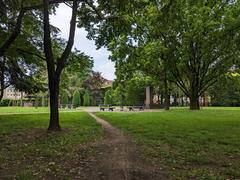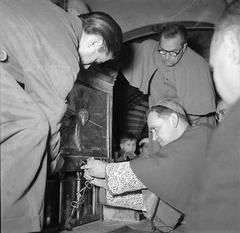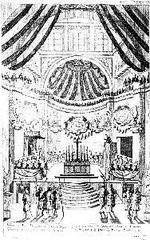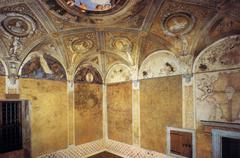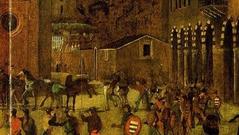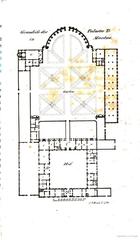Mantua Historical Sites: Visiting Hours, Tickets, and Travel Guide
Date: 14/06/2025
Introduction
Nestled in the heart of Lombardy, Northern Italy, Mantua (Mantova) is a city where history, art, and Renaissance splendor converge. Its origins date back to the Etruscan era around 750 BCE, and its urban landscape reflects centuries of Roman, medieval, and Renaissance development. Designated as a UNESCO World Heritage Site alongside Sabbioneta, Mantua offers travelers a journey through grand palaces, magnificent churches, and vibrant squares shaped by the influential Gonzaga dynasty (italia.it, UNESCO listing).
Mantua is celebrated for its remarkable artistic heritage—most notably the Camera degli Sposi frescoes in the Ducal Palace, the imaginative rooms of Palazzo Te, and the monumental architecture of the Basilica di Sant’Andrea. With a compact, pedestrian-friendly center, a scenic lakeside setting, and a lively cultural calendar (including the famed Festivaletteratura), Mantua is an ideal destination for lovers of history, art, and authentic Italian culture (cultureactivities.com, italyscapes.com, festivaletteratura.it, Monday Feelings).
This guide provides everything you need for a memorable visit: in-depth insights into Mantua’s historical sites, up-to-date visiting hours, ticketing options (including the Mantua Card), accessibility advice, travel tips, and recommendations for exploring local culture and cuisine.
Contents
- Mantua’s Ancient and Renaissance Origins
- The Bonacolsi and Gonzaga Dynasties
- Renaissance Splendor: Key Historical Sites
- Ducal Palace (Palazzo Ducale)
- Palazzo Te
- Basilica di Sant’Andrea
- Other Significant Sites
- Visiting Hours and Tickets
- Guided Tours and Accessibility
- Top Attractions and Practical Travel Tips
- Frequently Asked Questions (FAQs)
- Planning Your Visit: Travel, Accommodation, and Dining
- Summary and Recommendations
- Official Sources and Further Information
Mantua’s Ancient and Renaissance Origins
Mantua’s story begins with the Etruscans and evolves through Roman occupation, when its strategic position on the Mincio River fostered growth and prosperity. The city’s marshy surroundings historically served as a natural defense and influenced its medieval layout—including enduring landmarks like the Rotonda di San Lorenzo, Mantua’s oldest church (italia.it, finestresullarte.info).
In the late 13th century, the Bonacolsi family rose to power, leaving their mark with structures such as Palazzo Bonacolsi and Torre della Gabbia (nomadicniko.com). Their rule ended in 1328, marking the beginning of the Gonzaga dynasty, which transformed Mantua into a Renaissance powerhouse.
The Bonacolsi and Gonzaga Dynasties
The Bonacolsi family’s tenure established Mantua’s foundation as a fortified medieval city. When the Gonzaga family assumed control, they ushered in nearly four centuries of artistic, cultural, and urban flourishing. Their patronage attracted some of the Renaissance’s greatest talents, including Andrea Mantegna, Giulio Romano, and Leon Battista Alberti, whose works and architectural innovations are central to Mantua’s identity (italia.it, Monday Feelings).
Renaissance Splendor: Key Historical Sites
Ducal Palace (Palazzo Ducale)
A vast complex with nearly 600 rooms, 7 gardens, and 8 courtyards, the Ducal Palace was the residence of the Bonacolsi and later the Gonzaga family. It houses the renowned Camera degli Sposi, frescoed by Andrea Mantegna, and boasts grand halls filled with Renaissance masterpieces (italyscapes.com).
- Visiting Hours: Tuesday–Sunday, 8:15 AM–7:15 PM; closed Mondays.
- Tickets: €13.00 for combined Ducal Palace and Castello di San Giorgio (reduced €2.00).
Castello di San Giorgio
Integrated into the Ducal Palace, this moated fortress was built between 1395–1406. The Camera degli Sposi is its artistic centerpiece, and the towers offer panoramic city views.
Palazzo Te
Commissioned by Federico II Gonzaga and designed by Giulio Romano, Palazzo Te is celebrated for its Mannerist architecture and playful frescoes, especially the Sala dei Giganti. It was conceived as a suburban villa dedicated to leisure and grandeur (italyscapes.com).
- Visiting Hours: Tuesday–Sunday, 8:45 AM–7:15 PM; closed Mondays.
- Tickets: €12.00 (reduced €2.00).
Basilica di Sant’Andrea
A masterpiece by Leon Battista Alberti, the basilica dominates Piazza Andrea Mantegna. It houses relics believed to be earth soaked with the blood of Christ and features a monumental façade inspired by Roman triumphal arches (italyscapes.com).
- Visiting Hours: Daily, 7:15 AM–7:00 PM. Free entry (donations welcome).
Other Significant Sites
- Mantua Cathedral (Cattedrale di San Pietro Apostolo): Blending Romanesque, Gothic, and Baroque elements, it anchors Piazza Sordello and features remarkable interiors (adventurebackpack.com).
- Rotonda di San Lorenzo: The city’s oldest church, with unique Romanesque circular design.
- Piazza delle Erbe: A lively square surrounded by historic buildings, including the Torre dell’Orologio and Rotonda di San Lorenzo.
- Teatro Bibiena: An exquisite late Baroque theater where Mozart once performed (hayllarmusictours.com).
- Palazzo Bonacolsi: A prime example of 13th-century Gothic architecture.
- Church of San Sebastiano: Early Renaissance gem by Alberti.
- Museo di Palazzo San Sebastiano: Exhibits on the Gonzaga family and Mantua’s artistic heritage (tourspilot.com).
- Mincio River and Lakes: Lago Superiore, Lago di Mezzo, and Lago Inferiore offer scenic walks, cycling, and boat tours (tourspilot.com).
- Serraglio Park: Ideal for families and outdoor relaxation.
Visiting Hours and Tickets
- Most museums and monuments are closed on Mondays. Always check the latest schedules on official websites.
- Combined tickets (such as for the Ducal Palace and Castello di San Giorgio) and the Mantua Card provide cost-effective access to multiple sites and public transport (mantovacard.it).
- Advance booking is strongly suggested for popular attractions and festivals.
Guided Tours, Events, and Accessibility
- Guided tours (in several languages) are widely available and recommended for in-depth exploration.
- Accessibility: Many sites are wheelchair-friendly, but cobblestone streets and some older buildings may present challenges. Contact sites in advance for specific accommodations.
- Cultural events: The Festivaletteratura each September is a highlight, drawing international writers and readers (festivaletteratura.it).
Top Attractions and Practical Travel Tips
- Outdoor activities: Mantua’s flat terrain and lakeside paths are perfect for cycling and walking. Bike rentals are available, and guided cycling tours can take you through historic and natural sites.
- Local cuisine: Don’t miss dishes like tortelli di zucca, risotto alla pilota, and sbrisolona cake. Pair with local Lambrusco wine for an authentic taste of the region.
- Photo opportunities: Capture sunrise or sunset from Ponte San Giorgio for breathtaking city views.
Getting to Mantua
- By train: Regular services connect Mantua to Milan, Verona, Modena, and Bologna (trenitalia.com). The station is a 15-minute walk from the city center.
- By car: Mantua is close to the A22 motorway, with Park & Ride lots and shuttles to the center.
- By bicycle: Extensive bike paths make cycling popular and practical.
Accommodation and Dining
- Choose from boutique hotels, B&Bs in historic palaces, and modern lodgings. Book early during major festivals.
- Enjoy traditional Lombard and Emilian dishes in local trattorias and restaurants.
Safety, Language, and Practicalities
- Mantua is safe and tourist-friendly. Tap water is drinkable and credit cards are widely accepted.
- Italian is the official language; English is spoken in main tourist areas.
- Dress for the season, and check the weather forecast before your trip.
Frequently Asked Questions (FAQs)
Q: What are the main visiting hours for historical sites?
A: Most major sites open between 8:15/8:45 AM and close between 7:00/7:30 PM. Churches may close mid-day. Always check for up-to-date schedules.
Q: How do I purchase tickets?
A: Buy tickets onsite or online. The Mantua Card offers combined entry and public transport access.
Q: Are sites accessible for visitors with disabilities?
A: Many attractions are accessible, but some historic buildings have limitations. Inquire with the site before visiting.
Q: What is the best time to visit?
A: Spring and autumn for mild weather and fewer crowds; September for the Festivaletteratura.
Q: Are guided tours available?
A: Yes, walking, cycling, and Segway tours are available and highly recommended.
Summary and Recommendations
Mantua is a living museum of Renaissance art, history, and urban planning. Its UNESCO World Heritage status, combined with its rich cultural calendar, scenic lakes, and outstanding cuisine, make it a must-visit Italian destination. Plan your trip by booking tickets in advance, exploring by foot or bike, and delving into the city’s vibrant festivals. Download the Audiala app for interactive maps and audio guides, and follow us for the latest updates.
Official Sources and Further Information
- Mantua Historical Sites, Visiting Hours, Tickets & Travel Guide (italia.it)
- UNESCO World Heritage Status and Cultural Significance (UNESCO)
- Top Attractions and Visiting Hours for Mantua Historical Sites (ItalyScapes)
- Visiting Mantua: Hours, Tickets, and Essential Travel Tips (Turismo Mantova)
- Festivaletteratura Official Site (festivaletteratura.it)
- Culture Activities: Things To Do In Mantua (cultureactivities.com)
- Monday Feelings - What To Do In Mantua (Monday Feelings)
Images and virtual tours: For visual inspiration, see official tourism sites and linked resources. Use alt tags such as “Palazzo Ducale Mantua visiting hours” and “Palazzo Te Mantua tickets” for accessibility and SEO.

